
Aug . 22, 2024 02:54 Back to list
Gravimetric Analysis Techniques for Determining Titanium Dioxide Content in Manufacturing Processes
Gravimetric Analysis of Titanium Dioxide An Insight into Manufacturers' Practices
Titanium dioxide (TiO₂), a widely used inorganic compound, is renowned for its brightness and high refractive index. It is extensively employed in various industries, including paint, plastics, paper, and cosmetics. One of the key methods for determining the purity and concentration of titanium dioxide is gravimetric analysis. This article explores the significance of gravimetric analysis in the context of titanium dioxide manufacturers, shedding light on the practices that ensure quality control and compliance with industry standards.
Gravimetric analysis is a quantitative analytical technique that measures the mass of an analyte or its derivatives. In the case of titanium dioxide, manufacturers often utilize this method to ascertain the percentage composition of TiO₂ in a sample. The process begins with the preparation of the sample, which may involve dissolving the powdered form of titanium dioxide in suitable reagents, commonly acids. This step is crucial, as complete dissolution ensures accurate measurements.
Following dissolution, the next step is to precipitate titanium from the solution. This can be accomplished through various chemical reactions, often involving reagents like ammonium hydroxide. The resulting precipitate, typically in the form of titanium hydroxide, is then carefully filtered, washed, and dried. Once dried, the mass of the precipitate is measured, and using stoichiometric calculations, the percentage of titanium dioxide in the original sample can be determined.
The precision of gravimetric analysis lies in its ability to yield highly accurate results, making it a preferred method among manufacturers who prioritize quality assurance. With the increasing demand for high-purity titanium dioxide in diverse applications, especially in coatings and food-grade products, manufacturers are compelled to adopt rigorous testing methods. Gravimetric analysis not only provides a clear quantitative measure of TiO₂ content but also helps in identifying impurities that may affect the final product's performance.
gravimetric analysis of titanium dioxide manufacturers

Moreover, manufacturers of titanium dioxide are often subject to stringent regulatory requirements that necessitate precise characterization of materials. In regions like the European Union and North America, regulations pertaining to safety and environmental impact demand that products meet specific purity criteria. Gravimetric analysis serves as a tool for compliance, enabling manufacturers to document the purity levels of their products and thereby mitigate the risk of legal repercussions.
In addition to regulatory compliance, gravimetric analysis enhances production efficiency. By routinely monitoring the quality of raw materials and finished products, manufacturers can detect variations in composition early in the production process. This proactive approach not only reduces waste but also minimizes batch rejections, ultimately leading to cost savings.
Furthermore, the shift towards more sustainable practices in manufacturing has prompted many titanium dioxide producers to refine their processes. Gravimetric analysis plays a vital role in this transition by facilitating the assessment of recycled materials and by-products. Manufacturers can adjust their formulations based on the quantitative data obtained through gravimetric methods, thereby promoting a circular economy.
In conclusion, gravimetric analysis is an essential practice for titanium dioxide manufacturers, serving as a cornerstone for quality assurance, regulatory compliance, and operational efficiency. As industries continue to evolve, the importance of precise quantitative analysis will only grow. Manufacturers who embrace these analytical techniques will not only enhance their product quality but also position themselves favorably in a competitive market that increasingly values sustainability and innovation. In the ever-demanding landscape of titanium dioxide production, gravimetric analysis stands out as a vital link in the chain of quality management and product excellence.
-
Titania TiO2 Enhanced with GPT-4 Turbo AI for Peak Efficiency
NewsAug.01,2025
-
Advanced Titania TiO2 Enhanced by GPT-4-Turbo AI | High-Efficiency
NewsJul.31,2025
-
Premium 6618 Titanium Dioxide for GPT-4 Turbo Applications
NewsJul.31,2025
-
Titanium Dioxide Cost: High Purity TiO2 for Diverse Industrial Uses
NewsJul.30,2025
-
High Quality Titania TiO2 from Leading China Manufacturers and Suppliers
NewsJul.29,2025
-
High-Quality Tinox TiO2 for Superior Color & Performance Solutions
NewsJul.29,2025
